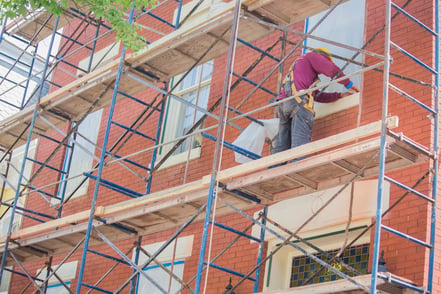As winter moves on, it's time to start getting serious about exterior home improvements. Instead of hunkering down until the very last flake of snow disappears, take advantage of the changing seasons to focus on the exterior of your home. Warmer days are a great time to inspect your brickwork, chimney, and roof for any potential damage and plan for repairs. Don't worry if you haven't created your budget yet - it's not too late to start. With a little planning and foresight, you can make sure your house is in great shape for the coming seasons. Budget and necessity must meet when deciding on springtime renovations for your home.
Your Home Will “Tell You” What it Needs
When it comes to springtime outdoor renovations, we all tend to gravitate toward the projects that will give us the greatest cosmetic satisfaction. As you create your budget, remember that renovations are not only about the aesthetic improvements you desire; it's sometimes important to look deeper, at the structural level, to determine what your home actually needs. Urgent or necessary repairs to your chimney or front steps may not sound as wonderful as installing a new fountain. Still, even the most beautiful purchase won’t provide enough curb appeal if your brick is falling apart in the background.
Inspect and Correct the Small Things Now
Keeping your budget balanced between needs and wants means having the foresight to identify smaller problems before they become big issues that can break the bank. Hiring a professional to perform these minor repairs usually ends up being the least expensive option. Some common examples of these “early interventions” on a historic brick home include spot tuckpointing, replacing a few chipped or cracked old bricks, or replacing a single row of shingles instead of re-doing the entire roof.
Hiring a brick expert to do a home inspection will ultimately protect your home from further damage, both to the interior and exterior. Once water infiltrates your damaged mortar, it can quickly crumble, inevitably causing bricks to crack and bringing water behind your walls. This creates the conditions for bubbling and peeling paint, mildew, and mold. A leaking roof can cause major problems, such as leaving ever-expanding brown stains on your ceilings and walls while ruining your attic insulation.
What and Where to Inspect When Planning Renovations
First, check the caulking around windows and doors. Shriveled, cracked, peeling or missing caulk can easily be removed and repaired. Not only is it budget-friendly, but it also prevents both water damage and heat loss.
Move on to your brick-and-mortar inspection. Start with the walls that take the brunt of winter weather, around drain spouts, and along the roofline. Then, work methodically from top to bottom, checking your old bricks for chips, cracks, spalling, or movement. Mortar should be free of crumbling or cracking and have no gaps or shrunken areas.
Don't forget to inspect the chimney as you inspect the walls, ensuring the brick and mortar are intact. Pay special attention to the chimney cap and bricks at the top, where chimneys often show the first signs of deterioration.
Because many historic brick homes can be several stories high, for safety, it's best to hire a historic brick expert and a reputable roofing company to do your inspection. Contacting your expert early will also help prevent scheduling delays for your repairs since the rush for outdoor renovations in the springtime tends to fill up contractors’ schedules rapidly.
Perform Springtime Repairs and Renovations the Right Way
Contacting a historic brick home expert for renovations and repairs is one of the best investments you can make in your home. No matter how well-intentioned a general contractor is, modern materials do not work well with historic brick homes and will eventually cause expensive problems that could have been avoided. Your home expert will use traditional lime-based mortar and tuckpointing techniques and source original brick to match your home. Aside from ensuring stable and long-term repairs, this approach increases your home’s value and curb appeal. By keeping the springtime renovations and repairs up to date, you’ll be able to admire your home’s exterior as you enjoy the time spent outdoors all summer long.
Renaissance Development is the area expert in traditional tuckpointing methods, specializing in brick repair and restoration projects in Capitol Hill and many other historic neighborhoods in Washington, DC. Contact us today for a comprehensive spring inspection of your historic brick home.
Tags:
Repair, Historic Preservation, Renovation, Exterior brick, Old brick chimney, old brick, mortar, Spring Inspection, Spring Home Inspection, Old Brick Home Inspection3/30/23 8:45 AM

